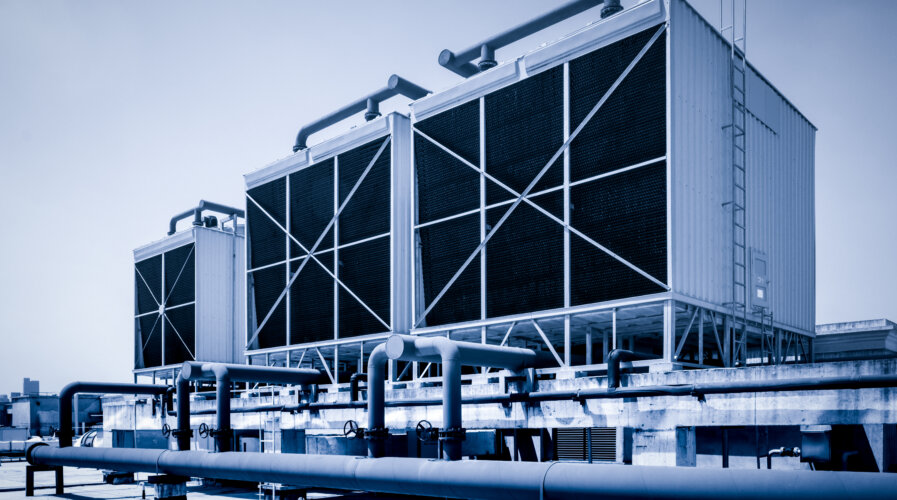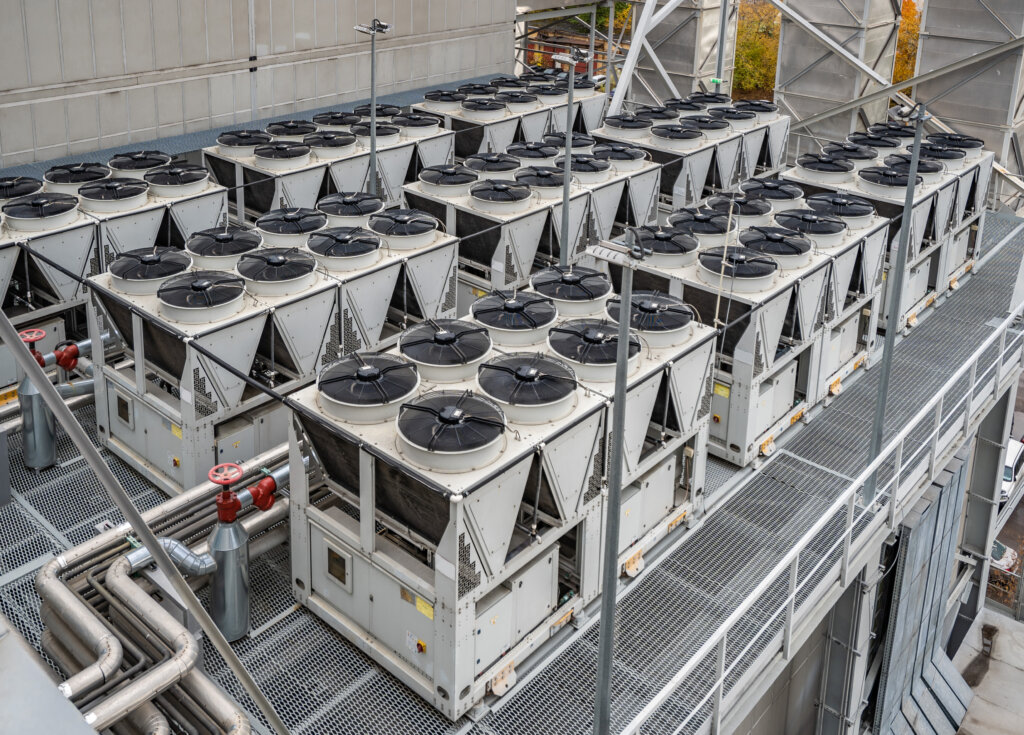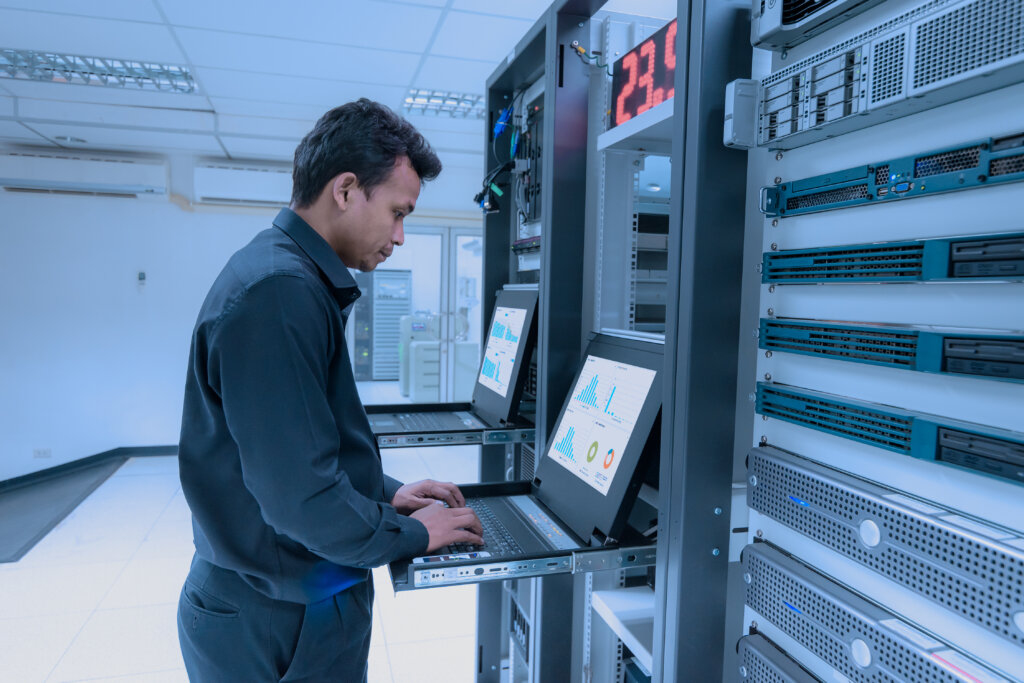
Cooling towers in data centers. (Image – Shutterstock)
Liquid cooling vs. air cooling in data centers
- While air cooling has been the dominant cooling method in data centers, liquid cooling is proving to be more sustainable.
- Data centers in tropical countries find it the best method for maintaining temperature.
- Iceotope’s Precision Liquid Cooling technology can efficiently dissipate heat from IT equipment.
Data centers generate a lot of heat and energy, running a large number of servers and other equipment hosted within them. While the heat generated in these data centers is useful in cooler climates, most tropical countries must ensure they have a robust cooling system in place.
According to the World Economic Forum, an initiative in Sweden called Stockholm Data Parks uses waste heat from data centers to warm people’s homes. In the Netherlands, a company called Switch Datacenters has reduced its reliance on natural gas by replacing gas generator units with data center heating.
However, these countries are in Europe, which generally does not experience the hot temperatures common in most Asian and tropical countries. Data centers in these warmer regions need more intensive cooling solutions to combat overheating, a significant disruptive problem.
Over the years, air cooling has been the dominant method for data centers. This approach involves filling the server room or data center with large air conditioning units to maintain suitable temperatures. Its low operational cost and ease of implementation make air cooling a preferred choice for managing heat in data centers.
Nevertheless, air cooling poses some challenges, especially in terms of sustainability. To minimize carbon emissions and meet sustainability goals, some data center operators are turning to liquid cooling as a preferred alternative.

An industry first for liquid cooling in the telco data centers.
This is where liquid cooling comes in. It involves the use of water or other fluids for efficient and cost-effective cooling of high-density racks—something with which air cooling is struggling to keep up.
For example, Google predominantly uses water to cool most of its data centers. The company has pledged to improve its water stewardship across Google office campuses and data centers, aiming to replenish water use while enhancing watershed health and ecosystems in water-stressed areas.
To understand more about liquid cooling in data centers, Tech Wire Asia spoke with Nathan Blom, CCO at Iceotope. Known for its precision cooling technology, Iceotope is leading the way in making liquid cooling a viable alternative to air cooling in data centers, particularly in achieving today’s sustainability goals.
TWA: How does precision liquid cooling outperform air cooling in data centers? Can a data center using air cooling easily switch to liquid cooling?

Nathan Blom, CCO at Iceotope
Precision Liquid Cooling offers superior thermal efficiency and improved energy consumption by circulating a liquid coolant through components to efficiently absorb and dissipate heat. This method has higher heat-carrying capacity than air, enabling more effective cooling of high-density server racks. It also minimizes temperature variations and hotspots, ensuring consistent performance and reducing the risk of hardware failures. Additionally, this feature eliminates the need for server fans, resulting in decreased noise and energy usage.
Data centers that rely on air cooling can successfully transition to precision liquid cooling, gaining significant benefits from its exceptional efficiency and sustainability advantages. In contrast, other solutions, such as tank immersion and direct-to-chip, may require more extensive adaptations and may not offer the same comprehensive benefits. Precision Liquid Cooling combines superior cooling performance with sustainability, making it an attractive choice for long-term investment.

Air cooling in data centers. (Image – Shutterstock)
TWA: What are the key benefits of Precision Liquid Cooling? Is it really energy efficient? Can you share some stats on this?
Precision Liquid Cooling has emerged as a best-in-class solution for data centers in hotter climates, offering several key benefits. Notably, it significantly boosts energy efficiency by directly channeling heat into the cooling liquid, thereby bypassing the need for energy-hungry air circulation. This method yields impressive results, including a 40% decrease in energy consumption and a remarkable 90% reduction in water usage, which enhances companies’ sustainability efforts.
In the face of Singapore’s tropical climate challenges, where maintaining ideal operating temperatures is a continuous struggle, precision liquid cooling excels by providing not only consistent but also reliable cooling performance. By minimizing thermal strain on components, the technology reduces the component failure rate by 30% and enhances overall system stability. With its increased efficiency, extended hardware lifespan, and smaller footprint, precision liquid cooling is well-suited to future-proof the market in tropical climates.

Temperature check in data center. (Image – Shutterstock)
TWA: Singapore recently announced new temperature operating standards. Is this move really sustainable?
The introduction of new temperature operating standards for data centers in Singapore is a major step toward achieving the city-state’s sustainability objectives. This move aligns with Singapore’s broader goals, such as its pursuit of net zero emissions, and demonstrates a promising strategy for boosting energy efficiency in data centers in tropical climates.
This initiative holds particular significance for Iceotope’s area of expertise because cooling systems can contribute up to 40% of a data center’s overall energy consumption. Our Precision Liquid Cooling technology can efficiently dissipate heat from IT equipment, maintaining stable and higher operating temperatures, which optimizes energy efficiency. It’s important to note that this technology can manage temperatures exceeding 26 degrees Celsius while simultaneously ensuring reliable cooling for sensitive equipment.
This development presents a huge opportunity for improved energy savings through heightened efficiency at elevated temperatures. Furthermore, given that the standards incorporate both temperature and humidity considerations, Precision Liquid Cooling systems can be tailored to manage these factors effectively, contributing to sustainable operations.
TWA: When it comes to edge computing, how does precision liquid cooling work?
Setting up hardware in challenging, off-the-grid settings with tight space and limited power is common in edge computing. Precision Liquid Cooling excels in such environments by efficiently dissipating heat, allowing powerful hardware to operate reliably in cramped spaces. The compact design of liquid cooling systems also saves room while delivering robust processing power at the edge.
A key differentiator lies in its seamless service model, where remote monitoring enables rapid responses and technicians can perform remote hot swaps, streamlining maintenance and mitigating environmental hazards. This advantage is particularly crucial for telco providers overseeing devices in remote networks. Although this process can be used for traditional data center facilities as well, it is a particularly potent solution for edge computing.
As data centers move toward the edge, Precision Liquid Cooling is poised to fortify these setups. By ensuring reliability, serviceability, and operational efficiency, it safeguards uptime and optimizes edge computing infrastructure performance, heralding a resilient future for enterprises.

Cooling towers in data centers. (Image – Shutterstock)
TWA: Ideally, how do you see the future of cooling in data centers, especially with rising temperatures already impacting the data center ecosystem?
There is a tipping point on the horizon for the evolution of data center cooling strategies. The impact of rising temperatures on the data center landscape is a primary driver of this change. As the need for computing power continues to grow, traditional methods of cooling that have supported data centers up to this point are quickly becoming inadequate.
As a result, we can expect a dramatic shift toward more innovative and effective cooling technologies, such as precision liquid cooling. These will be crucial for dynamically responding to ever-changing environmental conditions. By embracing these shifts and fostering innovation, a solid foundation will be set for a future in data center operations that is not only more sustainable but also more efficient.

Employee checking temperatures on racks. (Image – Shutterstock)
TWA: Lastly, why are some data centers not making the switch to Precision Liquid Cooling?
It’s crucial to acknowledge that transitioning to some liquid cooling solutions, whether through direct-to-chip or tank immersion methods, entails a substantial initial investment in both equipment and infrastructure modifications. This financial commitment can present a significant obstacle for many data centers, especially those not yet prepared to allocate resources for these necessary adjustments.
However, it’s also essential to highlight that Precision Liquid Cooling distinguishes itself markedly from previous liquid cooling solutions by offering a multitude of advantages that outweigh the drawbacks of other options.
Precision Liquid Cooling represents a significant departure from traditional data center cooling methods. It seamlessly combines the cooling performance benefits of direct-to-chip cooling with the sustainability advantages of tank immersion. It does so using the same rack-based architecture as air-cooled systems and is compatible with existing deployed infrastructure.
Precision Liquid Cooling’s unparalleled benefits in terms of sustainability, serviceability, and scalability make it an exceptionally attractive choice for data centers striving to meet evolving demands for data management and environmental responsibility.
Consequently, despite any initial reservations that data centers may have about liquid cooling, the remarkable advantages of precision liquid cooling clearly position it as a highly valuable and forward-looking long-term investment, distinguishing it as the superior choice among liquid cooling solutions.
READ MORE
- Safer Automation: How Sophic and Firmus Succeeded in Malaysia with MDEC’s Support
- Privilege granted, not gained: Intelligent authorization for enhanced infrastructure productivity
- Low-Code produces the Proof-of-Possibilities
- New Wearables Enable Staff to Work Faster and Safer
- Experts weigh in on Oracle’s departure from adland


